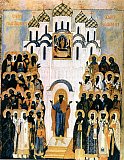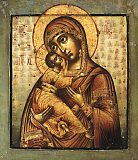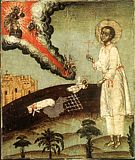 Meeting of the Vladimir Icon of the Most Holy Theotokos (1480).
Meeting of the Vladimir Icon of the Most Holy Theotokos (1480).  Martyr Agrippina of Rome and her companions Paula, Bassa, and Agathonica (253-259).
Martyr Agrippina of Rome and her companions Paula, Bassa, and Agathonica (253-259).  Synaxis of the Saints of Vladimir.
Synaxis of the Saints of Vladimir.
Martyrs Eustochius, Gaius, Proba, Lollia, and Urban, of Ancyra (4th c.). Second translation of the relics of St. Herman, archbishop of Kazan (1714). St. Artemius of Verkola (1545). Translation of the relics of St. Michael of Klops Monastery (Novgorod), fool-for-Christ (1482). St. Dionysius of Polotsk (1182). Sts. Vladimir and Agrippina, prince and princess of Rzhevsk (ca. 1226). Sts. Joseph, founder (1612), Anthony, and Ioannicius, abbots, of Zaonikiev Monastery, Vologda (17th c.).
New Hieromartyr Alexander Miropolsky, archpriest, of Kaslinsky Zavod (Ekaterinburg) (1918). New Hieromartyr Mitrophan (Krasnopolsky), archbishop of Astrakhan (1919).
Icons of the Most Holy Theotokos: “Umileniye” (“Of Tender Feeling”) of Pskov (1524), and “Zaonikiev.” (1588)
St. Etheldreda, foundress of Ely Monastery (England) (679). St. Nicetas of Thebes in Boetia and his disciples Theodore, Gregory, and Daniel (1079). Hieromartyrs Aristocleus, priest, Demetrian, deacon, and Athanasius, reader, at Salamis on Cyprus (306). Synaxis of the New Martyrs of Crete (1821-1822).
Repose of Schemamonk Zosimas of Solovki (1855) and Ivan M. Kontzevitch, spiritual writer (1965).
Monday. [Rom. 12:4-5, 15-21; Matt. 12:9-13]
It is lawful to do well on the
sabbath days. This is what the said Lord after healing
a man with a withered hand in the synagogue on the Sabbath
day as a reproach to the Pharisees, who took the
commandment about the Sabbath rest so far that they even
measured the number of steps they could make on that day.
But since it is not possible to do good deeds without
movement, they would sooner agree to neglect good deeds
than to allow any extra movement. The Saviour denounced
them for this time and again, because the Sabbath required
rest from worldly cares and not from deeds of piety and
brotherly love. In Christianity instead of the Sabbath
day, Sunday is celebrated with the same goal—rest
from all worldly affairs and devotion of that day solely
to deeds of God. Christian good sense never reached the
pharisaic pettiness concerning not doing things on Sunday;
but nevertheless the permissible allowance for doing
things on this day has been set far beyond the proper
limits. Not doing things alienated the Pharisees from
doing good deeds, whereas the things which Christians
allow themselves are what lead them away from good deeds.
On the evening before Sunday they go to the theatre, then
some other entertainment as well. In the morning they
oversleep and there is no time to go to church. There are
several visits, lunch, and in the evening again
entertainment. Thus all time is relegated to the belly and
pleasing the other senses, there is no time to even
remember God and good deeds.
Tuesday. [Rom. 14:9-18; Matt. 12:14-16, 22-30]
He that is not with me is against
me; and he that gathereth not with me scattereth
abroad. Who is with the Lord? He who lives and acts in
His spirit; he who allows himself neither thoughts, nor
feelings, nor desires, nor intentions, nor words, nor
deeds, which would be unpleasing to the Lord and in
opposition to His revealed commandments and
determinations. He who lives and acts otherwise, is not
with the Lord and consequently does not gather, but
scatters. What does he scatter? Not only energy and time,
but also what he gathers. For example, one who gathers
riches not with the Lord, amasses only riches, not sharing
with others, while depriving himself even of necessary
things; or another gathers them, spends a part on his own
luxurious lifestyle, part on donations made out of
vainglory, and saves part for his heirs. In the other
world he will appear with nothing—and there he will
be the poorest of the poor. On the contrary, one who
gathers riches with the Lord passes on what is gathered
through the hands of the poor and needy, unto eternal
treasuries. When such a person dies, he will find in that
world all his riches intact, not scattered, although he
spent them throughout his life. The same applies to the
gathering of knowledge. Here scattering is even more
obvious, because it can be seen how one who is
intellectual not in the Lord gathers a seeming mountain of
knowledge, but it is no more than rubbish—a phantom
of the truth, and not the truth. They not only lack
knowledge, but even loose human sense. They become
delirious, like one who is asleep. Read the systems of the
materialists and you will see that this is so.


![]() Meeting of the Vladimir Icon of the Most Holy Theotokos (1480).
Meeting of the Vladimir Icon of the Most Holy Theotokos (1480). ![]() Martyr Agrippina of Rome and her companions Paula, Bassa, and Agathonica (253-259).
Martyr Agrippina of Rome and her companions Paula, Bassa, and Agathonica (253-259). ![]() Synaxis of the Saints of Vladimir.
Synaxis of the Saints of Vladimir. 


















